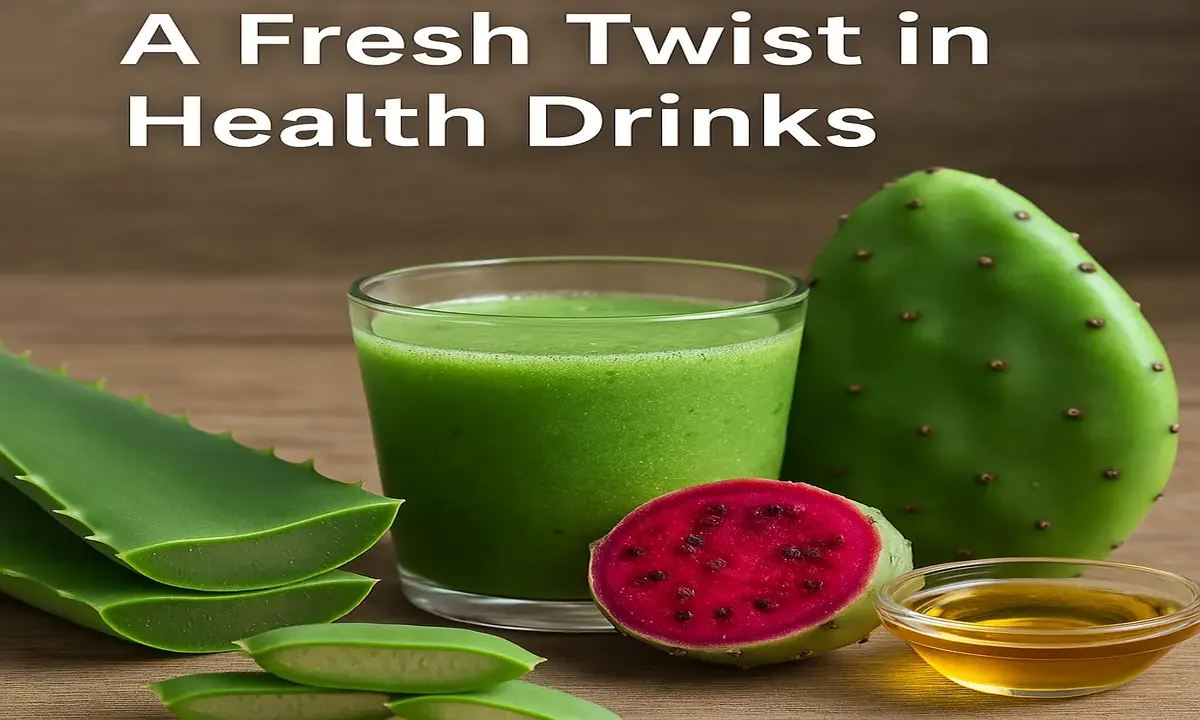Health drinks today are not what they used to be. Gone are the days when a plain green juice was the go-to for wellness seekers. Now, we’re seeing a curious new ingredient making its way into the scene—succulents.
That’s right. The same low-maintenance plants you might have on your office desk or kitchen window are now featured in smoothies, detox drinks, and wellness shots. But this isn’t just another trend for aesthetics. There’s real science, tradition, and health wisdom behind it.
In this article, we’re going to explore how succulents are used in health drinks, which types are safe and beneficial, how they’re prepared, and what they can do for your body. Let’s take a juicy dive into the world of succulent sips!
What Exactly Are Succulents?
Succulents are a group of plants known for storing water in their thick leaves, stems, or roots. This makes them perfect for surviving in dry, hot environments like deserts. They come in a wide variety of shapes, colors, and sizes.
Some people grow succulents as decorative plants, while others use them in herbal medicine and natural skincare. But what many don’t know is that a few select succulents are not just edible—they’re actually superfoods.
These edible types have been used for centuries in traditional medicine, especially in regions like South America, Africa, and Asia. Today, their benefits are being rediscovered and bottled into tasty, nutrient-packed beverages.
Read More: Is Laughing Cow Cheese Healthy?
Why Are Succulents Suddenly in Our Drinks?
There’s a growing demand for plant-based, natural, and functional health drinks. People want more than hydration—they want added value like vitamins, antioxidants, and digestive support. That’s where succulents come in.
Here’s why wellness brands are loving succulents:
- They’re nutrient-dense: Many succulents are full of vitamins A, C, and E.
- They’re hydrating by nature: Perfect for people who forget to drink water.
- They contain antioxidants: They help protect your body from stress and aging.
- They have digestive benefits: Some succulents can soothe the stomach and boost gut health.
- They bring a unique flavor: Mild, crisp, earthy, or slightly fruity.
These plants are a natural fit for clean-label beverages and eco-conscious consumers.
A Closer Look: Succulents Commonly Used in Beverages
Let’s look at the most popular succulents that are making their way into your wellness shots and smoothies.
1. Aloe Vera: The Soothing Superstar
Aloe vera is the rock star of the succulent world. Known for its healing gel, it’s used in skincare, sunburn relief, and now, health drinks.
How it’s used:
The clear inner gel is scooped from the leaves, cleaned, and blended into juices or smoothies.
What it brings to the table:
- Vitamins B, C, and E
- Hydration booster
- Digestive aid
- Mild laxative effect (if consumed in high amounts)
- It may help reduce acne when consumed regularly
Popular products:
Aloe King, OKF Aloe Vera Drink, and Forever Aloe Vera Gel
Flavor profile:
Slightly bitter on its own, often paired with fruit flavors.
2. Nopal Cactus: The Traditional Healer
Also known as the prickly pear cactus, this edible pad-shaped plant is a staple in Mexican cuisine—and a rising star in wellness drinks.
Uses in drinks: The pads and the fruit (called “tuna”) are used. They’re juiced, blended, or cooked.
Health benefits:
- It may help control blood sugar
- Supports liver detox
- High in antioxidants
- Anti-inflammatory properties
- Full of dietary fiber
Fun fact:
It’s been used in folk medicine to treat hangovers and high cholesterol.
Taste:
Mildly tart, slightly green or “grassy” in flavor.
3. Agave: More Than Just Syrup
Agave is well-known for its sweet nectar, but the plant itself is gaining attention in wellness drinks.
Used how:
Mainly for its natural sweetening properties. But newer drinks also use fermented agave for gut health.
Why people love it:
- Plant-based sugar alternative
- Contains inulin (a prebiotic fiber)
- May support digestion
- Lower glycemic index than regular sugar
Watch out:
Too much agave syrup can still spike blood sugar.
4. Purslane: The Hidden Gem
Often seen as a weed, purslane is an edible succulent rich in omega-3 fatty acids.
How it’s used:
Its small, juicy leaves are used in juices or teas.
Nutrition perks:
- Contains alpha-linolenic acid (a type of omega-3)
- Rich in vitamin C and magnesium
- Great for heart health and reducing inflammation
Where it’s popular:
In Mediterranean and Middle Eastern diets, it is often added to salads too.
5. Sea Beans: The Ocean’s Succulent
Sea beans, also known as salicornia or sea asparagus, grow in salty coastal areas.
Used in drinks?
Yes, especially in mineral-rich electrolyte blends.
Why it’s special:
- Packed with trace minerals
- Helps regulate fluids
- Naturally salty, ideal for sporty hydration drinks
Taste:
Crunchy, briny, and refreshing—like a sea breeze in your glass.
Also Visit: How Webfreen.com Enhances Your Green Spaces
How Are Succulents Processed for Safe Drinking?
While succulents are powerful, they can’t be consumed raw without care. Here’s how they’re usually processed before they reach your bottle:
- Harvesting carefully: Only certain parts of the plant are used.
- Peeling and washing thoroughly: Especially for aloe, which has a bitter latex layer that must be removed.
- Cold pressing or juicing: To retain nutrients.
- Fermentation or infusion: For added gut benefits and flavor variety.
- Drying into powders: For tea bags, mixable powders, or capsules.
Many high-end brands use organic or sustainable farming practices for these plants.
Benefits of Succulent-Based Drinks: What Science Says
Let’s talk results. What can these drinks actually do for your body?
Improved Digestion
Aloe vera and nopal cactus are both known to support the digestive system. Aloe helps soothe the stomach, while nopal provides fiber and prebiotics.
Stronger Skin and Hair
Succulent drinks rich in vitamin C and E may support collagen production. That means better skin texture and hair strength over time.
Better Hydration and Electrolyte Balance
Succulents like aloe and sea beans contain natural electrolytes. Perfect for rehydrating after exercise or a hot day.
Natural Detoxification
Nopal and aloe support the liver and kidneys, helping your body flush toxins more efficiently.
Potential Blood Sugar Support
Nopal cactus has shown potential in studies to help regulate blood sugar in people with type 2 diabetes.
Immune Boosting
Many succulent drinks are rich in antioxidants, which help strengthen your immune response.
DIY Recipes: Try It at Home
Here are a few easy recipes you can try:
1. Aloe-Lemon Cooler
Ingredients:
- 2 tbsp fresh aloe gel (clear only)
- 1 cup cold water
- 1 tbsp lemon juice
- 1 tsp honey
Blend and chill. Refreshing and great for digestion!
2. Nopal Cactus Smoothie
Ingredients:
- 1/2 cup diced nopal cactus (peeled and cleaned)
- 1/2 banana
- 1/2 cup pineapple juice
- 1/2 cup water
- Ice
Blend until smooth. Slightly tangy and great for energy.
3. Agave Mint Infused Tea
Ingredients:
- Green tea (brewed and cooled)
- 1 tsp agave nectar
- Fresh mint leaves
- Lemon slices
Serve over ice. Light, sweet, and soothing.
What to Look for in Store-Bought Drinks
Here are tips for picking a quality product:
- Choose cold-pressed or fresh varieties.
- Check for low sugar content.
- Look for certified organic or non-GMO labels.
- Avoid drinks with fillers, coloring, or artificial sweeteners.
- Read ingredient lists to ensure real succulent extracts are used.
Where to Buy Succulent-Infused Drinks
These drinks are becoming more available, especially online.
Retailers:
- Whole Foods Market
- Sprouts
- Trader Joe’s
- Amazon
- Thrive Market
- Local health food stores
Some brands to look for:
- Alo Drink
- True Nopal
- Cactus! Organic
- Lily of the Desert
- Baja Juice Co.
Are There Any Side Effects?
While generally safe, overconsumption or poor-quality products may cause:
- Stomach cramps
- Diarrhea (especially from too much aloe)
- Allergic reactions in rare cases
- Interference with certain medications
Always start with a small amount to see how your body reacts.
The Future of Succulents in Wellness
The popularity of these drinks shows no sign of slowing down. As consumers demand more plant-powered options, companies are exploring even more creative uses.
We might soon see:
- Succulent kombucha
- Functional coffee blends
- Succulent protein drinks
- Personalized succulent-based vitamin waters
It’s a beautiful mix of ancient tradition and modern nutrition.
FAQs
What are the best succulents to consume?
Stick with aloe vera, nopal cactus, agave, and purslane. These are safe, nutritious, and widely used.
Can I grow my own aloe and make juice?
Yes! Just make sure to use mature leaves and remove the yellow latex part before blending.
Are these drinks suitable for kids?
Most are fine in small amounts, especially aloe and fruit-based ones. Always check the label or consult a pediatrician.
How often should I drink them?
1 cup a day is a safe and healthy place to start. Rotate between types for variety.
Can I drink succulent drinks during pregnancy?
Some succulents like aloe vera may not be recommended during pregnancy. Always check with your doctor first.
Conclusion
Succulent-based health drinks are more than just a passing trend. They’re a fusion of traditional plant wisdom and modern wellness needs.
Whether you’re sipping on aloe juice, blending up a cactus smoothie, or adding agave to your tea, you’re nourishing your body in a refreshing and sustainable way.
Just remember: choose high-quality products, know your plants, and enjoy in moderation. The world of succulent sips is ready for you to explore—one tasty, healing glass at a time.












